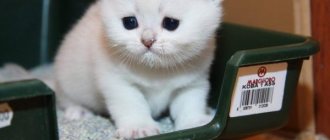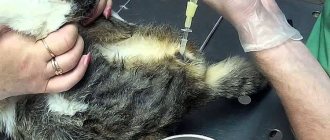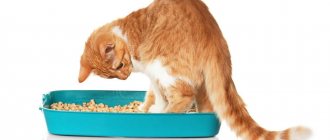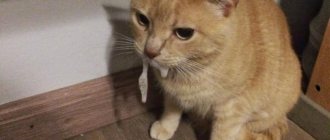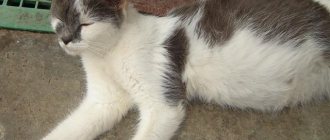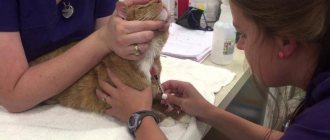Diagnostics and pre-medical preparation
Before contacting a veterinary clinic, the owner should carefully observe his pet so that the results of these observations will help the doctor make the correct diagnosis.
It is important to pay attention to the following points:
- how often does the cat bleed: once or after each visit to the toilet;
- how much blood the feces contain: a drop, a few drops, a clot or a large amount;
- are there any impurities in the stool: mucus, clots, hairballs, undigested food;
- how the cat behaves during defecation: screams, tense, worried or relaxed and calm;
- what happens to the pet’s appetite: the cat refuses to eat, the appetite is decreased or increased;
- how often does he drink water: is the animal thirsty;
- whether he has any accompanying symptoms: fever, vomiting, bloody diarrhea or constipation.
All changes in the pet’s condition and behavior must be described in detail to the veterinarian during the medical appointment.
What should stool be like?
The following parameters of cat feces are considered normal:
- Color. It should be brown. Both light and dark shades are allowed. The color of feces may change depending on the food you eat. So, if dairy products predominate in your pet’s diet, the feces will become significantly lighter. In some cases it acquires a yellowish tint. In cats that eat a lot of raw meat, it is dark brown. Green feces appear due to long-term use of antibacterial drugs and sulfonamides. They become colorless as a result of the development of hepatitis.
- Consistency. Ideally, cat feces are dense, well-formed, without crumbling, looking like a soft or compacted sausage with a smooth surface. Hard, dry feces indicate stagnation of the distal colon. So-called sheep feces, which look like small individual lumps, usually appear against the background of poor fluid intake, especially if the diet consists only of dry food. Less commonly, this may be a consequence of spastic colitis. Wet, poorly shaped stool is evidence of increased gastrointestinal motility due to excessive fiber intake. Pasty, unformed excrement means that the cat has increased contraction of the intestinal walls or there are infectious processes in the body. This may also be a consequence of intoxication. Watery liquid stool, in which there are no solid inclusions, indicates increased contractile function of the intestines, lack of absorption, acute intestinal infections, and severe poisoning. It acquires a ribbon-like shape due to the formation of hemorrhoids, sphincter spasms, trauma to the anus, and neoplasms in the rectum.
- The smell of cat feces should normally be specific, but not strong. That's what they call it - feces. It becomes putrefactive when the process of digestion and breakdown of proteins is disrupted, ulcerative colitis. A foul odor reminiscent of rancid oil is caused by dysfunction of pancreatic lipase secretion or obstruction of bile flow. It becomes sour due to fermentation processes or difficulty in absorbing fatty acids in the intestines.
Normally, stool is considered normal if it has the consistency of toothpaste. It should be soft, brown, 10-20 cm long. Defecation should occur without much strain, easily. Small deviations from this description should not immediately cause alarm. Stool (or feces) can change depending on lifestyle and dietary errors.
Treatment of constipation
Treatment for constipation in a cat depends on the causes of constipation. The main goal of therapy is to soften stool and remove it from the intestines.
If this is an isolated case, and it happened for the first time, then medications are not prescribed. If cases of defecation retention are frequent, the following methods are used:
- Water enema at the rate of 5-10 ml of water per 1 kg of animal weight. Enema with physiological saline solution with the same calculation of proportions. Enema with Vaseline oil. You can do an enema with Duphalac.
- Abdominal massage.
- Taking oral laxatives.
- Medicines that promote the movement of feces through the colon (Bisacodyl suppositories or glycerin suppositories for children). Suppositories are used alone or together with oral laxatives.
- Increased physical activity.
- Changing the feeding diet: introducing coarse wheat bran and canned pumpkin into the feed.
- Switching to food for cats with digestive disorders. Many brands have such lines, for example, Hill's ID, Royal Canin Fiber Response, etc.
How is diagnostics carried out in a veterinary clinic?
Based on your observations, as well as diagnostic measures, a diagnosis will be made. Diagnostics always includes drawing blood for a detailed analysis, as well as collecting pet’s feces for examination for internal bleeding, the presence of protozoan microorganisms and helminths.
A laboratory test is required - a coprogram, which allows you to find out the microscopic composition of cat feces and analyze its chemical and physical properties.
Additionally, the doctor may prescribe:
- Ultrasound of the abdominal organs;
- colonoscopy examination;
- Analysis of urine;
- allergen analysis;
- X-ray of the abdominal organs.
The result of all tests and studies will be the prescribed treatment, which must be strictly adhered to.
If a cat has blood in its stool, what should the owner do before visiting the clinic? First of all, you should carefully observe your pet. Particular attention should be paid to the following points:
- how often does this phenomenon occur (once or constantly, every time you visit the toilet);
- how much blood is released in the stool (droplets, clots, copious amounts);
- whether the animal’s behavior has changed when visiting the tray (tension and anxiety);
- are there other foreign impurities in the feces: mucus, undigested food particles, wool, etc.;
- how the animal’s appetite and thirst have changed;
- Is there any increase in temperature?
Having discovered bloody stool in a cat, you should also pay attention to changes in the pet’s thirst, general condition, presence of injuries, change in diet, the possibility of a foreign body entering the body and poisoning by rat poison. These questions will help a veterinary specialist quickly and correctly make a diagnosis, preserve the health, and sometimes even the life of the animal.
Provoking factors
In kittens, bowel problems are not considered a serious problem. With the transition to a new type of nutrition, this is not uncommon. It’s different for adult pets.
Most often, constipation in a cat signals the presence of illness. Therefore, if your pet does not go to the toilet for 3 days, you need to consult a doctor. In 60% of cases, the reason for the lack of bowel movements is chronic expansion of the colon (megacolon), narrowing of the pelvic canal, and nerve damage. And a breed like Manx cats has spinal cord damage.
There are other reasons for difficult bowel movements:
- Intestinal diseases (tumors, adhesions, polyps). Umbilical, inguinal hernias.
- Pelvic fracture, osteochondrosis, arthritis and other spinal problems.
- Long-term use of medications. Constipation in a cat occurs after antibiotics, long-term use of laxatives, and antispasmodics.
- After surgery with general anesthesia. If a castrated cat or a cat after sterilization cannot go to the toilet, this is a common occurrence.
- Worms. If routine deworming is not carried out and the animal spends a lot of time outside, then helminths can cause intestinal obstruction.
- Kidney and liver diseases.
- Neuralgia (pelvic nerve injury, spinal cord damage).
- Dehydration, excess calcium in the blood, low potassium levels.
Nervous constipation
In addition to physiological reasons, constipation can develop due to stress. Then they talk about neurogenic constipation. For example, an animal may not go to the toilet for several days if the living conditions have changed or due to a long move or change of housing.
Stool retention develops if the pet is not able to go to the toilet when he wants, since the tray is not accessible. The cat restrains the urge, which ultimately leads to disruption of the intestines and the formation of chronic constipation.
The problem can develop after childbirth due to stress and impaired intestinal motility. The same thing happens in sterilized cats - 3 factors play a role at once - stress, pain, narcotic drugs for anesthesia. Medicines used for anesthesia inhibit bowel function, which leads to fecal stagnation.
Alimentary constipation
Another reason why problems with bowel movements occur is poor nutrition. An increased protein content in the diet or a lack of fiber and vitamins often provokes difficult, rare passage of feces.
The diet must be balanced, especially when feeding natural foods. If the basis is dry food, then access to water is required. Incorrectly selected industrial food can also cause constipation.
Cats that eat kibble go to the toilet more often. This is due to the fact that dry cat food contains easily digestible ingredients and takes less time to digest.
Mechanical constipation
A foreign body in the intestines, for example, a bone fragment, can cause not only constipation, but also a more serious problem - volvulus.
Form
The shape of your stool can also tell you a lot about your internal health. Thin stool (resembling a pencil) should alert you. Perhaps some kind of obstruction is blocking the passage in the lower part of the intestine or there is pressure from the outside on the colon. This could be some kind of neoplasm. In this case, it is necessary to perform a colonoscopy to exclude a diagnosis such as cancer.
Hard and small feces indicate the presence of constipation. The cause may be an inadequate diet that excludes fiber. You need to eat foods high in fiber, do physical exercise, take flaxseed or psyllium husk - all this helps improve intestinal motility and ease stools.
Stool that is too soft and clings to the toilet contains too much oil. This indicates that the body does not absorb it well. You may even notice oil droplets floating. In this case, it is necessary to check the condition of the pancreas.
In small doses, mucus in the stool is normal. But if there is too much of it, it may indicate the presence of ulcerative colitis or Crohn's disease.
How to help a cat at home
In the first stages, when the problem has not started, the owner can help his pet himself.
Ways to combat constipation in cats at home:
The essence of the procedure is to lightly press your fingers on the stomach and massage clockwise. To achieve results, you need to massage regularly and for a long time. If after a massage your stomach gurgles, this is a good sign. If a day has passed and the cat has not gone to the toilet, they resort to laxatives.
Many owners write in their reviews that condensed milk can loosen the intestines. All you need to do is dilute condensed milk with raw water (1:1 ratio) and give it to your cat.
Vaseline oil lubricates the intestinal walls, softens its contents, and improves peristalsis. The product is given at the rate of 20 ml per 5 kg of animal weight using a syringe without a needle. If after 4 hours the situation does not change, another 5 ml of oil is injected.
The drug can be given every hour. However, the total dose should not exceed 40 ml. The fact is that Vaseline oil envelops the intestinal walls, and the resulting film interferes with the absorption of nutrients.
Flaxseed oil will also help get rid of constipation. It does not cause harm, but on the contrary, has a beneficial effect on the irritated intestinal mucosa. Olive and sunflower oils are suitable for cleansing.
When constipation occurs in a cat, treatment can be carried out with laxatives. Duphalac, Lactusan are suitable.
Advantage is given to Duphalac. The drug is given gradually: the first 2 days, 0.5 ml twice a day. The next 2 days, 1 ml 2 times a day. Over the next 2 days, the dosage is increased by the same amount. If the stool becomes viscous and half-shaped, similar to plasticine, return to the previous dose.
Treatment with Duphalac is recommended to be combined with abdominal massage and feeding the cat probiotics. These can be medications (Linex, Bifiform) or products: homemade yogurt, kefir.
Enema Microlax, Normaze, Senade can also be used in therapy. However, before treating constipation in a cat yourself, it is important to consider all the risks and contraindications.
How to treat blood in stool
We told you what to do before going to see a doctor, now let’s talk about how the treatment will proceed. Treatment for this pathology may include the following:
- injections of antibiotics to reduce inflammation in the cat's intestines;
- prescription of antibacterial, anti-inflammatory, antihistamine and other drugs;
- surgery to remove polyps and cancerous tumors;
- use of anthelmintic drugs for helminthic infestation;
- elimination of the inflammatory process in the paraanal glands: drainage, treatment with medicinal solutions;
- transferring the animal to a special therapeutic diet;
- prescribing laxatives to loosen stools and facilitate bowel movements;
- installing IVs if there is a risk of dehydration;
- inserting suppositories with medicines and sea buckthorn oil into the cat’s anus;
- installation of an enema for emptying and cleansing the intestines of feces.
We suggest you read: Diseases of old cats and kittens: symptoms and treatment
A treatment regimen, medications and a therapeutic diet should be prescribed by a doctor after making a final diagnosis.
Self-medication in this case is unacceptable! It can lead to serious deterioration of the pet's condition and death.
What is constipation?
A healthy cat normally goes to the toilet once a day. Aging animals empty their intestines less often - once every 2-3 days.
Constipation in cats does not depend on gender, age or breed. It is noted that it occurs more often in cats (70% of cases in males and 30% in females) of middle age.
Insufficient defecation is a collective concept. It may mean difficult, infrequent bowel movements or its complete absence. In veterinary medicine, it is customary to distinguish 3 types of delayed bowel movements, the symptoms and treatment of which are different:
- Constipation is a partial retention of stool, when feces are released in small quantities or when difficulties arise periodically, but the cat defecates, although rarely, on its own.
- Obstipation is a serious condition in which feces clog the intestines and harden in it. The cat cannot poop on its own.
- Coprostasis - feces do not move through the intestines, complete blockage occurs.
Some veterinarians call cat constipation a symptom of systemic illnesses, while others identify them as a separate disease.
Other characteristics
According to its characteristics, feces in an adult are directly related to lifestyle and nutrition. What causes an unpleasant odor? Pay attention to what you've been eating more frequently lately. A foul odor is also associated with taking certain medications and can manifest itself as a symptom of some kind of inflammatory process. In cases of food absorption disorders (Crohn's disease, cystic fibrosis, celiac disease), this symptom also appears.
Floating stool in itself should not be a cause for concern. If the floating stool has a very unpleasant odor or contains a lot of fat, this is a symptom of poor absorption of nutrients in the intestine. In this case, body weight is quickly lost.
What affects the change in the color of stool to white or gray - the reasons for its discoloration
An element called stercobilin is responsible for the color of stool; it is the end product of the breakdown of bilirubin. Stercobilin colors stool brown. Therefore, light-colored feces indicate a lack of stercobilin. You can read more about the process of coloring excrement and the color variations it can take in the article about the color of feces.
Now let's find out what may be associated with a lack of coloring pigment.
White feces as a result of gallbladder dysfunction
One of the most common causes of white stool is blockage of the gallbladder ducts. Stercobilin is a bile pigment and, due to the difficulty of its transportation, feces become discolored, becoming white, gray or clay-colored. Other symptoms may indicate problems with bile transport, the most obvious being yellowing of the eyes and skin. Blockage of the bile ducts can occur due to tumors or the formation of stones. Stones, in turn, are very dangerous, since the bile duct connects to the pancreatic duct, which will lead to disruption of its secretions.
IT IS IMPORTANT TO KNOW!
Gallstones form due to poor nutrition or frequent fasting. The gallbladder requires regular contractions, which occur during meals. When the gallbladder contracts, it releases bile into the intestines to break down fats. During fasting, there is no contraction and, accordingly, no release of bile, which leads to the formation of stones!
When the pancreatic ducts are blocked, its juices will begin to corrode its own tissues, which will further contribute to the leakage of pancreatic juice, which in turn will begin to break down the body from the inside and can be fatal. Therefore, white feces is one of the signs of the need for an urgent medical examination.
Light-colored stool as a symptom of liver dysfunction
The liver plays one of the main roles in digestion. It is in it that bile acids are formed, which then accumulate in the gallbladder. This is not the only process occurring in the liver that causes the stool to change color to gray or white. A lot of different processes and metabolisms of various kinds of substances occur in the liver. In particular, the metabolism of bilirubin, during the breakdown of which the coloring pigment stercobilin is formed. Various types of liver dysfunction can also appear as white feces.
Other causes of white stool in adults
White feces can be caused not only by the reasons described above; the microflora of the intestine itself can affect the change in the color of poop. Light-colored feces occur when bile pigments do not interact properly due to changes in intestinal microflora.
The microflora, in turn, may change for the following reasons:
- Use of any medications that contribute to intestinal dysbiosis. This phenomenon most often occurs while taking antibiotics.
- Perhaps you have recently experienced severe stress, which could contribute to changes in the intestines that cause lightening of the stool.
- A sudden change in diet or poor nutrition also leads to intestinal dysfunction. This is a stressful situation for the body. Therefore, this factor can be attributed to the above. Most often, this factor influences the change in color of stool to gray in children when changing their diet.
The above-mentioned reasons for changes in intestinal microflora most often cause white feces.
If your feces have changed color to white, gray or clayey and this is accompanied by other changes in your body, for example, nausea, sudden changes in temperature, pain in the liver, yellowing of the eyes or skin, then most likely the cause of the white feces is a malfunction liver and gall bladder. In such cases, you should not self-medicate. Problems with these organs can lead to serious consequences, including death. And incorrect self-treatment will only negatively affect the situation and instead of providing treatment, you only finish off your organs. Our body is an integral system, everything in it is interconnected. And if some organ fails, perhaps the source of the problem is in a completely different place. To identify the cause, it is necessary to undergo a series of tests and conduct an examination; this cannot be done at home.
Preventive actions
While cleaning the cat's litter box, owners may notice that the cat has bloody stool, what does this mean and is it worth worrying about - the main question that is asked in this case to a veterinarian. The presence of blood clots (extravasates) in the feces, or even a pool of blood in the tray, is an alarming sign of the development of pathology in a pet. Under no circumstances should the situation be left to chance. It is necessary to understand the cause and provide the animal with qualified assistance.
Read in this article
A coprogram is...
Chyme, or food gruel, moves through the gastrointestinal tract and fecal masses are formed in the large intestine. At all stages, breakdown occurs, and then absorption of useful substances occurs. The composition of the stool helps determine whether there are any abnormalities in the internal organs. A scatological examination helps to identify a variety of diseases.
A coprogram is a chemical, macroscopic, microscopic examination, after which a detailed description of the feces is given. Coprograms can identify certain diseases. These may be disorders of the stomach, pancreas, intestines; inflammatory processes in the digestive tract, dysbiosis, malabsorption, colitis.
Bristol scale
English doctors at the Royal Hospital in Bristol have developed a simple but unique scale that characterizes all the main types of feces. Its creation was the result of the fact that experts were faced with the problem that people are reluctant to open up about this topic; embarrassment prevents them from talking in detail about their stool.
Based on the developed drawings, it became very easy to independently characterize your own bowel movements without any embarrassment or awkwardness. Currently, the Bristol Stool Shape Scale is used throughout the world to assess the functioning of the digestive system. For many, printing a table (types of feces) on the wall in your own toilet is nothing more than a way to monitor your health.
1st type. Sheep feces
It is called so because it is shaped like hard balls and resembles sheep feces. If for animals this is a normal result of intestinal function, then for humans such stool is an alarm signal. Sheep pellets are a sign of constipation and dysbacteriosis. Hard feces can cause hemorrhoids, damage to the anus, and even lead to intoxication of the body.
2nd type. Thick sausage
What does the appearance of stool indicate? This is also a sign of constipation. Only in this case are bacteria and fibers present in the mass. It takes several days to form such a sausage. Its thickness exceeds the width of the anus, so emptying is difficult and can lead to cracks and tears, hemorrhoids. It is not recommended to self-prescribe laxatives, as sudden release of feces can be very painful.
3rd type. Sausage with cracks
Very often people consider such stools to be normal, because they pass easily. But make no mistake. Hard sausage is also a sign of constipation. When defecating, you have to strain, which means there is a possibility of anal fissures. In this case, irritable bowel syndrome may be present.
4th type. Ideal chair
The diameter of the sausage or snake is 1-2 cm, the feces are smooth, soft, and easily amenable to pressure. Regular bowel movements once a day.
5th type. Soft balls
This type is even better than the previous one. A few soft pieces form and come out gently. Usually occurs with a large meal. Stool several times a day.
6th type. Unshaped chair
The feces come out in pieces, but unformed, with torn edges. It comes out easily without hurting the anus. This is not diarrhea yet, but it is already a condition close to it. The causes of this type of stool can be laxative medications, increased blood pressure, excessive consumption of spices, and mineral water.
7th type. Loose stools
Watery stools that do not include any particles. Diarrhea requiring identification of causes and treatment. This is an abnormal condition of the body that needs treatment. There can be many reasons: fungi, infections, allergies, poisoning, liver and stomach diseases, poor diet, helminths and even stress. In this case, you should not postpone your visit to the doctor.
Stool retention in kittens: reasons
Constipation in a kitten is a common problem that every owner should be prepared for. It occurs especially often in artificial kittens that are raised without a mother.
A kitten fed by a cat rarely has problems with bowel movements. Newborn kittens cannot empty their bowels on their own. Their mother helps them. She licks the stomach and anus and thereby stimulates peristalsis.
Immediately after birth, kittens' intestines are sterile. The colostrum they receive from their mother fills it with beneficial bacteria. If the baby is bottle-fed, then he does not receive these bacteria and, due to dysbacteriosis, problems with stool may develop. Moreover, constipation in a newborn kitten occurs regardless of what it is fed: milk, baby food or cat milk replacer.
The intestines of a week-old kitten digest only milk. When switching to artificial feeding, both delayed bowel movements and diarrhea are equally possible. Both conditions are dangerous: constipation causes body poisoning, and diarrhea leads to dehydration.
At 1 month, when complementary feeding begins, constipation is an expected phenomenon. The diet changes, is replenished with food, and the microflora has to adapt to digest new substances.
At 2 months, vaccination is carried out, which can also upset the balance of microflora and provoke a delay in bowel movements in a small kitten.
When feeding natural food, constipation in kittens occurs when the diet is unbalanced, especially when the fiber content is insufficient.
Kittens are active and inquisitive. A common cause of obstruction is ingestion of a foreign body.
Diagnosis of the condition
A pet with a characteristic symptom should be shown to a veterinarian who, after a clinical examination, will prescribe certain diagnostic methods. First of all, the doctor will conduct a detailed blood test, stool examination for helminths, protozoa, and occult blood.
An informative research method is the coprogram. Using this laboratory method, you can find out not only the microscopic composition, but also detect hidden blood in the feces of an animal. If necessary, a urine test will be performed. An ultrasound or X-ray examination of the abdominal organs, as well as a colonoscopy, can be used to find out why a cat poops blood.
We suggest you read: To what age do toy terriers grow?
Feces in children
Many mothers are interested in what baby’s stool should be like. It is worth paying special attention to this factor, since gastrointestinal diseases are especially severe at an early age. At the first suspicion, you should contact your pediatrician immediately.
In the first days after birth, meconium (dark color) comes out of the body. During the first three days, light-colored feces begin to mix in. On the 4-5th day, feces completely replace meconium. During breastfeeding, golden-yellow feces are a sign of the presence of bilirubin, paste-like, homogeneous, and acidic. At the 4th month, bilirubin is gradually replaced by stercobilin.
With various pathologies, there are several types of feces in children, which you need to know about in order to prevent various diseases and unpleasant consequences in time.
- “Hungry” cal. The color is black, dark green, dark brown, the smell is unpleasant. Occurs with improper feeding or fasting.
- Acholic feces Whitish-gray color, discolored, clayey. With epidemic hepatitis, biliary atresia.
- Putrefactive. Pasty, dirty gray, with an unpleasant odor. Occurs during protein feeding.
- Soapy. Silvery, shiny, soft, with mucus. When feeding with undiluted cow's milk.
- Fatty feces With a sour odor, whitish, a little mucus. When consuming excess fat.
- Constipation. Gray color, hard consistency, putrid odor.
- Watery yellow stool. When breastfeeding due to a lack of nutrients in mother's milk.
- Pasty, thin stool, yellow in color. It is formed due to excessive feeding of cereals (for example, semolina).
- Feces for dyspepsia. With mucus, coagulated, yellow-green in color. Occurs when there is an eating disorder.
Animal treatment
In the case where a cat poops blood due to a disease of the pancreas, the liver may be prescribed enzyme preparations that improve digestion. If fur is detected in feces and the formation of hairballs is suspected, special pastes and foods are prescribed to expel them from the stomach.
In case of poisoning with anticoagulants, bleeding disorders, perforation of the intestinal walls with bones, hemostatic drugs and vitamin K are prescribed.
If the cause of the symptoms is a foreign body, polyps, or malignant tumors, then only surgical intervention with further conservative treatment can help the pet.
If blood is detected in the animal's stool, the owner should understand that such a symptom is a deviation from the norm. The variety of causes accompanying this symptomatology makes diagnosis difficult. That is why you should not hesitate to visit a doctor. In addition, some causes (foreign bodies, poisoning) require urgent veterinary attention.
People usually contract T. gondii disease in two ways: by eating undercooked meat from infected animals or through contact with cat feces.
Some studies have shown that mental disorders such as schizophrenia, depression and anxiety are more common in people with toxoplasmosis, while others suggest that the disease may affect a person's level of aggression and extraversion, note researchers from the Karolinska Institutet, Sweden.
In this new study, a laboratory experiment was conducted by researchers who discovered that human dendritic cells, which are an important part of the immune system, began releasing the signaling chemical GABA after being infected with toxoplasmosis.
GABA suppresses feelings of fear and anxiety. Disorders of the GABA system occur in people with depression, schizophrenia, bipolar disease, anxiety, and other mental disorders.
Although research has found a link between the system's immune response to toxoplasmosis gondii and a mental health problem, it does not prove a cause-and-effect relationship.
If the act of defecation occurs untimely and with long delays, this can lead to intoxication of the animal and other serious negative consequences. If you notice that the cat does not go to the toilet or meows and makes other sounds when defecating, spends a lot of time on this process, but often without results, if the feces are dry and the amount is small, you can talk about constipation in the cat.
If the stool turns black, this may indicate the presence of digested blood, which indicates internal bleeding in the upper digestive tract.
If blood is found in the stool in the state in which everyone is accustomed to seeing it, scarlet or bright red, it means that the blood has not been digested and bleeding is taking place in the lower parts of the digestive tract. In any case, the presence of bleeding in any part of the digestive tract should not be ignored and prompt assistance from a veterinarian.
If your pet's stool has acquired a greenish or yellowish tint, this may indicate problems with digestion of food, dysbiosis and other digestive disorders. If the stool is completely light yellow or even beige, white, this is an indication of a malfunction of the liver.
Grayish feces indicate problems with digesting the food you eat. If the feces are oily or watery, this may indicate failures in the absorption of excess fluid by the intestinal walls.
If any of the listed manifestations of changes in the quality, quantity, or consistency of your cat’s stool occur, you should immediately contact your veterinarian, take stool tests, and, having received the results and referrals from a specialist, begin treatment.
Cleaning the cat's litter box sometimes turns into an unpleasant surprise for the pet owner. Having noticed blood in a cat’s stool, a caring owner immediately begins to worry and takes the pet for a consultation with a veterinarian. In fact, such a symptom begins to appear against the background of a serious disease of the internal organs related to the gastrointestinal tract.
In the tray of his pet, the owner may find feces that differ in shape:
- ointment-like;
- mushy;
- liquid;
- foamy;
- in the form of “goat peas”;
- in the form of a tape or pencil.
By smell they distinguish: sour, rancid, putrefactive.
- Feces acquire a sour smell when the absorption of fatty acids in the small intestine is disrupted or due to fermentation processes in the large intestine.
- An unpleasant odor, similar to the smell of bad oil, occurs when the secretory function of the pancreas is disrupted or when the flow of bile is disrupted.
- The smell of rotting occurs when digestion in the stomach is disrupted, dyspepsia develops with the proliferation of putrefactive microflora in the intestines. Or the cat suffers from colitis with ulcerations.
We suggest you read: What kind of water can be poured into an aquarium?
It is customary to distinguish feces by color:
- red (beetroot);
- black (tarry);
- dark brown;
- light brown;
- with a scarlet admixture (undigested blood);
- yellow;
- light yellow;
- greenish yellow;
- bleached slightly yellow, gray, gray-white.
A healthy cat can have red or beetroot feces if it has eaten beets or food colored with bright dyes. This coloring is not pathological and soon the stool acquires a normal color.
Causes
The causes of diarrhea are varied. Stool disorders are accompanied by both mild food indigestion and serious diseases of the whole body or its individual organs.
Alimentary diarrhea
Associated with the animal’s nutrition, these include:
- Eating poor quality food. This is the most common cause of loose stools. Diarrhea can be caused by expired food or food that has been stored in open packaging for a long time. Insufficiently processed meat trimmings. A cat may pick up something spoiled while walking outside.
- Food allergies. Your cat may experience indigestion when eating certain types of foods. Adult cats often have food allergies to cow's milk.
- Poisoning. In addition to food poisoning from low-quality dairy and meat products, animals can be poisoned by poisonous indoor plants and chemical household products.
- Abrupt transition from one type of food to another. You should not suddenly change the type of food; introduce new foods gradually, in small portions.
Infectious diarrhea
Diarrhea is accompanied by many infectious and invasive diseases:
- Bacterial infections – colibacillosis, salmonellosis, etc.
- Viral infections – panleukopenia, leukemia, etc.
- Invasive diseases (caused by helminths and protozoa). With infections and infestations, in addition to diarrhea, general depression, fever, vomiting, and conjunctivitis (inflammation of the mucous membranes of the eyes) may be observed.
Dyspeptic diarrhea
They occur when there is a lack of digestive secretions necessary for digesting food. Such diarrhea is accompanied by diseases of the stomach, liver, and pancreas.
Neurogenic diarrhea
Occurs in stressful situations, under the influence of excitement or fear. Associated with disruption of the nervous regulation of intestinal motility by the central nervous system. Diarrhea due to nervousness occurs when a change of environment, moving, or the appearance of a new animal or person in the house.
Drug-induced diarrhea
Long-term use of antibiotics and other antibacterial drugs destroys the natural intestinal microflora, resulting in the development of dysbacteriosis.
Toxic diarrhea
Occurs due to poisoning with arsenic, mercury and other pesticides, toxic drugs. Often such poisoning in cats occurs when they eat poisoned mice or rats, or when they overdose on anthelmintic drugs.
Treatment tactics depending on the cause of the symptom
Some causes of blood in a cat's stool require medical intervention. For example, if an animal has swallowed a foreign object, it needs to undergo urgent surgery (otherwise the cat will die). If the owner notices bloody feces in a cat, he and his pet should immediately visit a veterinarian. Fulfilling this requirement is especially important if the animal develops the following alarming symptoms:
- painful sensations during bowel movements;
- stomach ache;
- vomit;
- decreased appetite;
- weakness;
- blood and mucus in the cat’s stool;
- heat;
- the presence of blood or blood clots around the cat's anus.
The cat's body is exposed to great stress when bleeding and damage occurs in the intestines. To prevent the animal from experiencing unbearable pain, the owner must promptly pay attention to the pet’s health problems, provide first aid and conduct a thorough diagnosis in a veterinary clinic.
The behavior and well-being of a pet is an indicator of its health. If, during occasional blackening of the feces, the animal is in an active and cheerful state, there is no reason to contact a veterinarian. Immediate delivery to a veterinary clinic requires the appearance of the following symptoms:
- Bloody clots in the stool, which are a sign of internal bleeding in one of the organs of the digestive system. This phenomenon is very dangerous. The slightest delay in this situation can result in the death of your pet.
- Changing the cat's behavior. A pitiful meow that intensifies when you try to touch his stomach, and slight trembling are sure signs of problems in the gastrointestinal system.
- Hyperthermic syndrome.
- Melena (black, semi-liquid stool with a foul odor).
- Vomiting or false retching.
- Lethargy. A very dangerous sign is the state of a pet when it lies indifferently, pressing its muzzle to the floor, and does not react to external stimuli.
- Decreased appetite or complete refusal to eat.
- Absence or, on the contrary, excessive thirst.
- Increased frequency of the urge to empty the bladder.
- Pallor of gingival tissues.
- Wounds or hematomas on the body.
When diagnosing stones or neoplasms in a cat, or detecting a foreign object, there is only one way out - surgical intervention. In other cases, the treatment plan is developed individually for each four-legged patient.
| Main disease | Group of drugs | Names of drugs |
| Worm infestation | Antiparasitic | Milbemax, Stronghold, Prasitel, Drontal, Dirofen |
| Sand in the gallbladder | Choleretic | Cholenzyme, Allochol, dehydrocholic acid |
| Inflammation | Antibiotics | Streptomycin, Erythromycin |
| Antiviral | Fosprenil, Anandin, Gamapren, Gamavit, Cycloferon | |
| Stomach lesions | Gastroprotectors | De-Nol, Maalox, Almagel, Ranitidine |
Causes of blood and mucus in the stool of a cat and possible ways to eliminate them
When diagnosing stones or neoplasms in a cat, or detecting a foreign object, there is only one way out - surgical intervention. In other cases, the treatment plan is developed individually for each four-legged patient.
We suggest you read: Skin pigmentation in animals
| Main disease | Group of drugs | Names of drugs |
| Worm infestation | Antiparasitic | Milbemax, Stronghold, Prasitel, Drontal, Dirofen |
| Sand in the gallbladder | Choleretic | Cholenzyme, Allochol, dehydrocholic acid |
| Inflammation | Antibiotics | Streptomycin, Erythromycin |
| Antiviral | Fosprenil, Anandin, Gamapren, Gamavit, Cycloferon | |
| Stomach lesions | Gastroprotectors | De-Nol, Maalox, Almagel, Ranitidine |
Blood in a cat's stool: causes and possible treatments
The well-being and health of a pet depends entirely on its owner, who must not only feed the animal every day, but also monitor its health. To do this, you should periodically check that your urine and feces do not contain blood. If your cat starts meowing loudly during bowel movements, it means something is bothering her. And bloody stool can be a symptom of various health problems for your pet.
Blood can only enter natural products from the gastrointestinal tract. A more precise location of the damage can be determined by paying attention to its color.
It happens that a cat has bloody stools, or the bowel movement process is disrupted in a different way. In this case, this is a symptom indicating a violation of the animal’s health. First of all, it is worth identifying what caused this phenomenon, as well as in what cases it is necessary to contact specialists.
Blood in the stool is quite common, and if it happens just once, don’t be alarmed.
For example, during constipation, the animal will strain to defecate, which will cause minor bleeding. As soon as the stool returns to normal, the problem will disappear.
In small kittens, with bright scarlet discharge, the cause may be the ingestion of a foreign body.
This is due to the fact that children can play with various sharp objects, including small stones. This element is not digested and comes out with feces.
If there are helminths, the blood in the cat's stool will be in the form of brown clots.
Animals infected with worms may recover with blood mixed in them for several days until they are given appropriate treatment.
What can an owner do before going to a veterinary hospital?
If the owner begins to notice that the cat has blood in its stool, he needs to observe the pet before taking it to the veterinarian. You should pay particular attention to the following points:
- how often does blood appear in the cat’s stool (every time he visits the litter box or just once);
- how the cat behaves in the tray (worry, tense or, conversely, calm and relaxed);
- how much blood does the stool contain (a few drops, clots, or a large amount);
- are there foreign impurities in the stool (undigested food, mucus, hairballs);
- whether the cat’s appetite has changed, whether the animal is suffering from thirst;
- does the cat have a fever?
- Your pet may be suffering from vomiting or diarrhea.
If you find blood in your cat's feces, observe the general condition of the animal. The slightest changes in behavior, the presence of thirst, loss of appetite, lethargy, or the entry of a foreign body into the cat’s body should be discussed with the veterinarian at the appointment. A specialist, having determined the causes of blood inclusions in a cat’s stool, will be able to quickly make a diagnosis and develop an effective treatment plan. Thanks to this, the life and health of your pet will be preserved.
Causes of constipation in cats
The following diseases can be noted as causes of constipation in cats:
- congenital organic pathologies;
- perineal hernia;
- inflammation of the rectum;
- diseases of the large intestine;
- tumors of the digestive organs;
- cyst.
Cats even have neurogenic constipation, which appears in stressful situations or when the limbs are diseased - it is difficult for the animal to take a comfortable position to recover.
But still, most often the factors that cause constipation in cats are poor nutrition or an ingested foreign body.
In long-haired cats, congestion causes an accumulation of hairballs, which, when licked, first clog the esophagus and then enter the intestines.
Metabolism in the body of animals is disrupted with age - in aging cats, hard feces appear more often due to impaired bile secretion.
Diagnostic features
To find out why a cat has blood in its stool, a veterinarian performs a diagnosis. The procedure involves the use of different techniques, but first of all, blood is taken for a detailed analysis. It is also necessary to submit your pet’s stool to be examined for protozoan microorganisms and helminths, as well as to detect internal bleeding.
A laboratory method called coprogram is highly informative at the stage of diagnosing diseases in cats. With its help, you can find out what microscopic composition the blood in cat feces has, as well as identify hidden bleeding. Additional tests performed when blood is detected in a cat's stool:
- Analysis of urine;
- Ultrasound of the abdominal organs;
- X-ray of the abdominal organs;
- colonoscopy examination.
A set of diagnostic procedures allows the veterinarian to make the correct diagnosis and create an effective treatment regimen.
Treatment of a cat with blood in the stool
Treatment for a cat is prescribed by a veterinarian after identifying the exact reasons for the appearance of blood in his stool. The therapeutic course for such a pathology may consist of the following points:
- injections of antibiotics (such drugs reduce inflammation in the animal’s intestines);
- changing the diet plan (a balanced medicinal food is selected for the pet that will not cause allergies or intolerances);
- performing surgical procedures to remove tumors and polyps;
- use of anthelmintics;
- elimination of inflammation in the paraanal glands (the cavity is treated with a medicinal solution or drainage is done);
- taking laxative medications that thin the stool and facilitate the passage of feces through the intestines;
- installation of an enema to flush the intestines from feces;
- installation of IVs to maintain the cat’s vital functions (the method is used if the pet does not eat, is tormented by vomiting, and there is a risk of developing dehydration).
The choice of treatment for a pathology in which blood is found in a cat’s feces depends on the final diagnosis. The owner of the cat must remember that self-therapy is unacceptable, as it can lead to dire consequences and a serious deterioration in the pet’s condition. For example, if a cat is given a laxative when a foreign body is detected in the intestines or helminthic infestations, the prognosis for recovery will worsen.
Treatment of diarrhea
In the absence of serious signs of illness, it is not necessary to take the kitten to the veterinary clinic. If the disease is in the initial stage and, apart from problems with stool, the animal does not experience other serious ailments, you can begin treatment at home:
- It is necessary to exclude food from your pet's diet that could cause diarrhea. You need to remember what foods the animal has been fed recently. It is especially important to know what new items have been introduced into the diet. In most cases, diarrhea is caused by the abrupt removal of the kitten from the cat's mother and the transfer of its diet to fermented milk, cow's milk and canned food intended for older animals. Various disorders of the gastrointestinal tract are caused by foods from the human table (meat, fish, sausages, etc.), which owners often treat their pets to.
- For 10-12 hours, the kitten can be put on a starvation diet, but it cannot be kept on it for more than the specified time. Water must be freely available. Immediately after a twelve-hour hunger strike, the kitten must be fed. To alleviate your pet's condition, you can feed him rice water without rice, only the boiled liquid itself. Also, to speed up the evacuation of toxins, you can give the kitten an adsorbent (Smecta, Enterosgel).
- Put the kitten on a diet. You can feed him boiled rice, hard-boiled eggs, and boiled lean meat (chicken or beef). This diet does not cause allergies, but at the same time provides the kitten with the necessary amount of nutrients. In this case, the menu can be enriched with vitamin supplements (check their quantity with your veterinarian).
- For a quick recovery, the kitten needs special care and rest . Do not forcefully play with him, do not frighten him or expose him to overload. This will help your pet recover faster if diarrhea is caused by stress.
